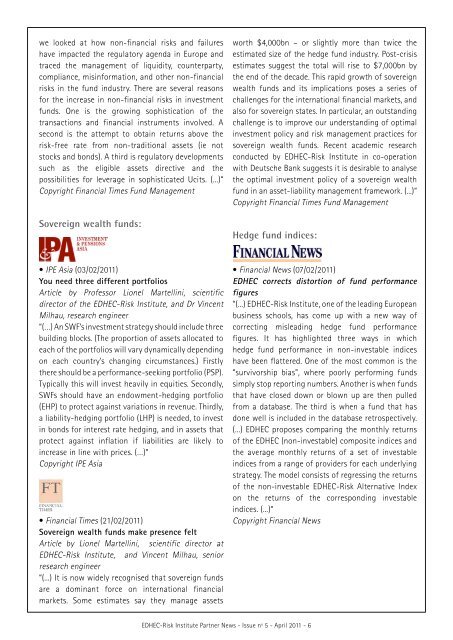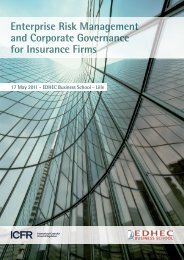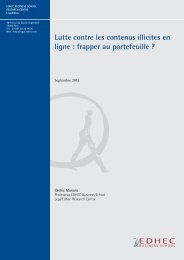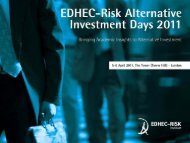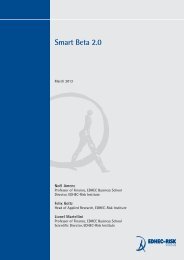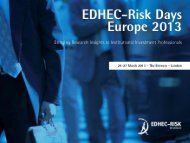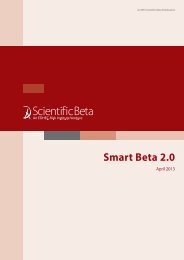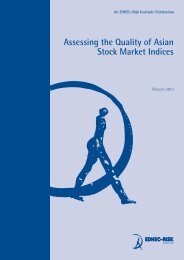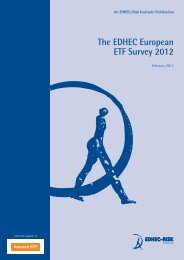Create successful ePaper yourself
Turn your PDF publications into a flip-book with our unique Google optimized e-Paper software.
we looked at how non-financial risks and failures<br />
have impacted the regulatory agenda in Europe and<br />
traced the management of liquidity, counterparty,<br />
compliance, misinformation, and other non-financial<br />
risks in the fund industry. There are several reasons<br />
for the increase in non-financial risks in investment<br />
funds. One is the growing sophistication of the<br />
transactions and financial instruments involved. A<br />
second is the attempt to obtain returns above the<br />
risk-free rate from non-traditional assets (ie not<br />
stocks and bonds). A third is regulatory developments<br />
such as the eligible assets directive and the<br />
possibilities for leverage in sophisticated Ucits. (...)“<br />
Copyright Financial Times Fund Management<br />
Sovereign wealth funds:<br />
worth $4,000bn – or slightly more than twice the<br />
estimated size of the hedge fund industry. Post-crisis<br />
estimates suggest the total will rise to $7,000bn by<br />
the end of the decade. This rapid growth of sovereign<br />
wealth funds and its implications poses a series of<br />
challenges for the international financial markets, and<br />
also for sovereign states. In particular, an outstanding<br />
challenge is to improve our understanding of optimal<br />
investment policy and risk management practices for<br />
sovereign wealth funds. Recent academic research<br />
conducted by <strong>EDHEC</strong>-<strong>Risk</strong> <strong>Institute</strong> in co-operation<br />
with Deutsche Bank suggests it is desirable to analyse<br />
the optimal investment policy of a sovereign wealth<br />
fund in an asset-liability management framework. (...)“<br />
Copyright Financial Times Fund Management<br />
Hedge fund indices:<br />
• IPE Asia (03/02/2011)<br />
You need three different portfolios<br />
Article by Professor Lionel Martellini, scientific<br />
director of the <strong>EDHEC</strong>-<strong>Risk</strong> <strong>Institute</strong>, and Dr Vincent<br />
Milhau, research engineer<br />
“(…) An SWF’s investment strategy should include three<br />
building blocks. (The proportion of assets allocated to<br />
each of the portfolios will vary dynamically depending<br />
on each country’s changing circumstances.) Firstly<br />
there should be a performance-seeking portfolio (PSP).<br />
Typically this will invest heavily in equities. Secondly,<br />
SWFs should have an endowment-hedging portfolio<br />
(EHP) to protect against variations in revenue. Thirdly,<br />
a liability-hedging portfolio (LHP) is needed, to invest<br />
in bonds for interest rate hedging, and in assets that<br />
protect against inflation if liabilities are likely to<br />
increase in line with prices. (…)“<br />
Copyright IPE Asia<br />
• Financial Times (21/02/2011)<br />
Sovereign wealth funds make presence felt<br />
Article by Lionel Martellini, scientific director at<br />
<strong>EDHEC</strong>-<strong>Risk</strong> <strong>Institute</strong>, and Vincent Milhau, senior<br />
research engineer<br />
“(...) It is now widely recognised that sovereign funds<br />
are a dominant force on international financial<br />
markets. Some estimates say they manage assets<br />
• Financial <strong>News</strong> (07/02/2011)<br />
<strong>EDHEC</strong> corrects distortion of fund performance<br />
figures<br />
“(...) <strong>EDHEC</strong>-<strong>Risk</strong> <strong>Institute</strong>, one of the leading European<br />
business schools, has come up with a new way of<br />
correcting misleading hedge fund performance<br />
figures. It has highlighted three ways in which<br />
hedge fund performance in non-investable indices<br />
have been flattered. One of the most common is the<br />
“survivorship bias”, where poorly performing funds<br />
simply stop reporting numbers. Another is when funds<br />
that have closed down or blown up are then pulled<br />
from a database. The third is when a fund that has<br />
done well is included in the database retrospectively.<br />
(...) <strong>EDHEC</strong> proposes comparing the monthly returns<br />
of the <strong>EDHEC</strong> (non-investable) composite indices and<br />
the average monthly returns of a set of investable<br />
indices from a range of providers for each underlying<br />
strategy. The model consists of regressing the returns<br />
of the non-investable <strong>EDHEC</strong>-<strong>Risk</strong> Alternative Index<br />
on the returns of the corresponding investable<br />
indices. (...)“<br />
Copyright Financial <strong>News</strong><br />
<strong>EDHEC</strong>-<strong>Risk</strong> <strong>Institute</strong> <strong>Partner</strong> <strong>News</strong> - Issue nº 5 - April 2011 - 6


